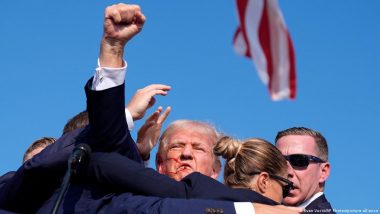Right after he was attacked, a bloodied Donald Trump raised his clenched fist, leading to iconic photos. Where does the gesture come from?Donald Trump, face covered in blood, raising his fist militantly in the air as security guards try to push the ex-president down to protect him — an iconic image.
Also Read | India News | SpiceJet Posts 6-fold Jump in Profit to Rs 119 Cr for March Quarter.
"In the worst situation a person can find themselves, in the face of death, the person shot at is not thinking first and foremost about themselves, but about their mission," media analyst Marion Müller told DW.
And it's effective. Trump's clenched fist — not a victory sign, but a gesture of fierce determination and enormous anger — makes him a martyr in the eyes of his supporters, one with a messianic message.
"Trump is making a promise of salvation here," Müller said. It's about the victory of an idea, i.e., the reelection of the former president, who claims he was was cheated out of victory in the last election. "Many Trump fans — and the US is a deeply religious country — interpret Trump's message as God's will," adds Müller, "as the visual symbol of a mission to lead the country."
Trump is aware of the power of images
Trump knows about the power of images. "If there had been a similar situation in Russia, with a similar gesture from President Vladimir Putin," believes Marion Müller, "it probably wouldn't have been shown publicly there."
In Russia, the incident would have been played down, perhaps explained away as a gun that had "accidentally gone off." Afterward, however, a beaming Putin would have appeared in Russian media. "But the US media are attuned to such iconic images," says Müller. It was not the moment before, when Trump ducked away, or after, when he was led into a black car, that was chosen by the media. "This image was chosen because it fits perfectly into the iconic and pathos-laden tradition of American presidential communication."
The hand as a symbol of the working class
The hand started appearing as a symbol of the political aspirations of the working class in the 19th and 20th centuries, according to late German ethnologist Gottfried Korff. It represented the political actors aiming for economic and social change.
The hand "is more than just an organic, muscular gripping instrument included in our basic biological equipment," Korff pointed out in an article for wissenschaft.de. It reveals a proximity to manual work.
The hand first emerged in political depictions and logos around the period of the German Revolution of 1848. Intertwined hands became the symbol of a young, organized workforce that relied on brotherhood and solidarity.
Then, a first major wave of strikes swept through Europe toward the end of the 19th century. Representations of clenched fists, raised in battle, reinforced the workers' demands for better working conditions and social security. "The explosive power of social issues can be represented with the clenched fist," wrote cultural scientist Korff.
The fist: From weapon to symbolic threat
The clenched fist is nevertheless an immemorial gesture, the now-deceased researcher Roland Posner, former head of the Semiotics Department at the Technical University of Berlin, once wrote.
The fist, humanity's most basic weapon, combines the strength of the hand and the arm.
The sight of a clenched fist can often appear as a threat or challenge to flight. It is very likely that even people in the Stone Age clenched their fists to defend their cave, family, supplies and fire that were vital to their survival.
Paintings on 2,000-to-3,000-year-old Greek vases show people using their hands in fistfights, clenched in victory or showing insulting gestures.
A wide variety of political movements later used the raised fist as a logo.
Socialist movements use a red fist, sometimes combined with a rose. A black fist stands for Black Power, the civil rights movement of African Americans. Feminists also combine a clenched, raised fist with a Venus symbol for the women's liberation movement.
An "Aryan fist" is used by white supremacists such as neo-Nazis globally and the Ku Klux Klan in the United States. For example, the right-wing terrorist mass murderer Anders Behring Breivik saluted with a raised fist in court in Oslo in 2012.
What makes the raised fist a political battle signal, a concentrated message? The English naturalist Charles Darwin once speculated on this.
In his treatise "The Expression of the Emotions in Man and Animals," published in 1872, he recognized the clenched fist as being typical of anger. "Gestures such as raising the arms with clenched fists as if to strike the insultor," Darwin wrote, "are very common." And, he wrote, "only a few people in great passion ... can resist the impulse."
This article was originally written in German.
(The above story first appeared on LatestLY on Jul 15, 2024 08:30 PM IST. For more news and updates on politics, world, sports, entertainment and lifestyle, log on to our website latestly.com).













 Quickly
Quickly




















